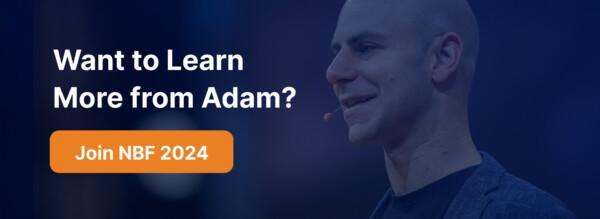15May2024
Adam Grant is an organizational psychologist and bestselling author who explores the science of motivation, original thinking, and potential. Adam has been Wharton’s top-rated professor for seven consecutive years and has been featured on the Thinkers50 list five times. His books have sold millions of copies, and the TED podcasts Re:Thinking and WorkLife, which he hosts, have been downloaded over 65 million times.
In anticipation of Adam’s visit to Nordic Business Forum 2024 in Helsinki, we took a closer look at his ideas on psychological safety, motivation, and potential. Let’s dive in!
Leaders Create Psychological Safety
“Whether or not you work in an industry where mistakes have disastrous consequences, psychological safety is a vital ingredient for healthy, effective, creative work.”
Adam emphasizes the importance of psychological safety for employees to take risks and explore their potential. He also believes that leaders play a pivotal role in creating such a safe environment in workplaces: “Psychological safety doesn’t just bubble up naturally—leaders have to create it. And it often takes more effort than we realize.”
But how can leaders foster psychological safety to encourage experimentation and learning? In his WorkLife podcast focusing on psychological safety, Adam outlines a few ways leaders can cultivate such a culture:
- Set the tone: Acknowledge your fallibility and appreciate those who point it out. Demonstrate openness to feedback, admit mistakes, and show vulnerability. This will encourage your employees to speak up without fear of retribution.
- Create regular touchpoints: Systematically make space and time for people to give feedback, and repeatedly ask them to raise concerns. This could be through structured meetings or informal catch-ups where employees can voice concerns and ideas.
- Work on accountability: Enhance psychological safety by clarifying that accountability goes both ways. Let your team know that you will hold them accountable for their work and demand they hold you accountable for yours.
Flow and Focus as Motivation Drivers
Employee motivation and engagement are a continuous challenge in organizations, and Adam has also shared his thoughts on this matter. In 2021 in the midst of the pandemic, he popularized the word “languishing,” a joyless and aimless feeling and a sense of stagnation and emptiness. But it’s not unique to that period of time. According to Adam, it’s a part of the human condition.
“Two decades of research show that languishing can disrupt your focus and dampen your motivation. It’s also a risk factor for depression, because languishing often lurks below the surface.”
Adam also says that the danger is that people don’t always notice being in this condition, so they don’t seek help or take any action to help themselves.
Luckily, Adam has a few ideas on what the antidotes for languishing can be:
- Embrace flow: “Flow is that elusive state of absorption in a meaningful challenge or a momentary bond, where your sense of time, place and self melts away.”
- Make time and space for focus: “Fragmented attention is an enemy of engagement and excellence. Give yourself some uninterrupted time.”
- Focus on small goals: “One of the clearest paths to flow is a just-manageable difficulty: a challenge that stretches your skills and heightens your resolve.“
While any individual can use these pieces of advice to get themselves motivated and engaged, leaders can play an important role too. Adam, for example, suggests that companies should set quiet times as a standard policy to help their employees find flow and focus.
“Languishing is not merely in our heads—it’s in our circumstances.”
Ways to Unlock Hidden Potential
Adam’s most recent book ‘Hidden Potential’ focuses on offering ideas on how anyone can improve and succeed. First, Adam underlines that we tend to put too much emphasis on the starting point rather than the potential.
“What look like differences in natural ability are often differences in opportunity and motivation.”
“If we judge people only by what they can do on day 1, their potential remains hidden. You can’t tell where people will land from where they begin. With the right opportunity and motivation to learn, anyone can build the skills to achieve greater things.”
Then, we come to question how. Adam offers numerous tips for helping your team reach their full potential, such as:
- Show the way: “When people can’t see the path, they stop dreaming of the destination. To ignite their will, we need to show them the way.”
- Practice character skills: “Personality is not your destiny, it’s your tendency. Character skills enable you to transcend that tendency to be true to your principles. It’s not about the traits you have, it’s what you decide to do with them.”
- Ask for advice: “Instead of seeking feedback, you’re better off asking for advice. Feedback tends to focus on how well you did last time. Advice shifts attention to how you can do better next time.”
Adam’s insights can help individuals reach their full potential and guide leaders to empower their teams to reach higher results. Whatever your position, keep in mind Adam’s encouraging words: “What any person in the world can learn, almost all persons can learn.”
Key to Becoming a Courageous Leader
The theme of Nordic Business Forum 2024 is Courageous Leadership. As Adam will also be stepping on our stage, we wanted to know how he would define courageous leadership:
“Courageous leadership is choosing to do things that are hard but right over those that are easy but wrong. My best advice for becoming a courageous leader is to reflect on the costs of failing to live by your principles.”

 by:
by: 

